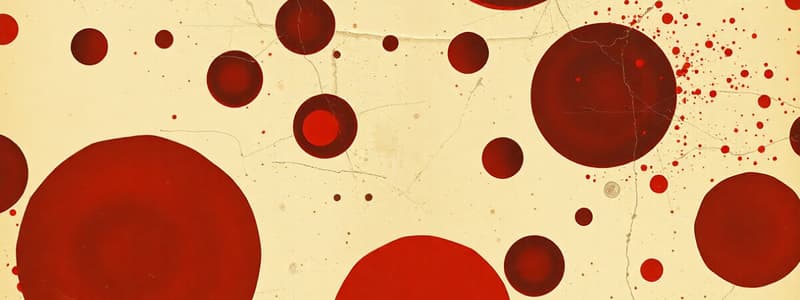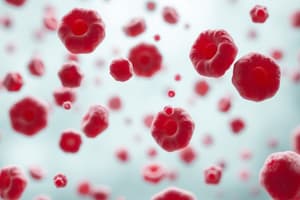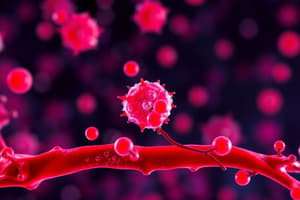Podcast
Questions and Answers
What does the term 'pancytopenia' refer to?
What does the term 'pancytopenia' refer to?
Pancytopenia refers to low numbers of all blood cells, affecting both myeloid and lymphoid cell types.
How does iron deficiency anemia manifest morphologically?
How does iron deficiency anemia manifest morphologically?
Iron deficiency anemia is characterized by microcytic and hypochromic red blood cells.
What role do vitamin B12 and folic acid play in the formation of blood cells?
What role do vitamin B12 and folic acid play in the formation of blood cells?
Vitamin B12 and folic acid are essential for the synthesis of deoxynucleotides, which are necessary for cell division in the bone marrow.
What is the primary deficiency in pernicious anemia?
What is the primary deficiency in pernicious anemia?
What influences the classification of anemia from a pathogenetic perspective?
What influences the classification of anemia from a pathogenetic perspective?
How does the bone marrow appear in cases of aplastic anemia?
How does the bone marrow appear in cases of aplastic anemia?
What types of red blood cells are typically observed in macrocytic anemia?
What types of red blood cells are typically observed in macrocytic anemia?
What are the two main types of anemia identified based on morphological classification?
What are the two main types of anemia identified based on morphological classification?
What defines normocytic anaemia in terms of MCV?
What defines normocytic anaemia in terms of MCV?
List two types of macrocytic anaemia and their common causes.
List two types of macrocytic anaemia and their common causes.
What is the characteristic feature of microcytic anaemia?
What is the characteristic feature of microcytic anaemia?
What are some causes of decreased red blood cell production?
What are some causes of decreased red blood cell production?
How is hypochromic anaemia classified and what does it indicate?
How is hypochromic anaemia classified and what does it indicate?
What distinguishes sideroblastic anaemia from other types?
What distinguishes sideroblastic anaemia from other types?
What role do reticulocytes play in understanding anaemia?
What role do reticulocytes play in understanding anaemia?
Identify one consequence of vitamin B12 deficiency observed in anaemia.
Identify one consequence of vitamin B12 deficiency observed in anaemia.
What are the two main categories of hemolytic anemias based on their origin?
What are the two main categories of hemolytic anemias based on their origin?
How does chronic bleeding lead to iron deficiency anemia?
How does chronic bleeding lead to iron deficiency anemia?
What is the consequence of reticulocyte count elevation in the context of normocytic anemia?
What is the consequence of reticulocyte count elevation in the context of normocytic anemia?
What type of genetic defects can lead to corpuscular hemolytic anemias?
What type of genetic defects can lead to corpuscular hemolytic anemias?
In thalassemia, what is meant by the term 'quantitatively matched' regarding globin chain production?
In thalassemia, what is meant by the term 'quantitatively matched' regarding globin chain production?
What dietary requirement is necessary to maintain adequate iron levels for red blood cell production?
What dietary requirement is necessary to maintain adequate iron levels for red blood cell production?
What are the clinical manifestations of sickle cell anemia?
What are the clinical manifestations of sickle cell anemia?
How does the presence of autoantibodies affect the red blood cells in extracorpuscular hemolytic anemias?
How does the presence of autoantibodies affect the red blood cells in extracorpuscular hemolytic anemias?
What role does the spleen play in hereditary spherocytosis?
What role does the spleen play in hereditary spherocytosis?
What characterizes the morphological classification of anemia?
What characterizes the morphological classification of anemia?
Flashcards are hidden until you start studying
Study Notes
Low Erythropoietin
- Low erythropoietin can be caused by severe kidney damage, chronic inflammation, or severe protein malnutrition.
- Erythropoietin is a hormone that stimulates the production of red blood cells.
Normal and Aplastic Bone Marrow
- Pancytopenia is a condition where all blood cells are low in number.
- Pancytopenia can be caused by damage to the bone marrow, where blood cells are produced.
Anaemia as a Part of Pancytopenia
- Pancytopenia affects both myeloid and lymphoid blood cells.
- Myeloid cells include red blood cells, granulocytes, monocytes, and platelets.
- Lymphoid cells include different types of lymphocytes.
Anaemia from Deficiency of Essential Factors
- Deficiencies in iron, vitamin B12, or folic acid can cause anemia.
- These deficiencies can lead to microcytic or macrocytic anemia, which may also be hypochromic.
- The bone marrow may contain enough hematopoietic cells, but they may appear abnormal.
Iron Deficiency Anemia
- Iron is essential for heme synthesis, which is a key component of hemoglobin.
- Erythropoiesis requires approximately 30 mg of iron daily, but the body only absorbs 1 to 2 mg from food.
- Iron is recycled extensively throughout the body.
Vitamin B12 and Folic Acid Deficiency Anemia
- Folic acid and vitamin B12 are necessary for the synthesis of deoxyribonucleotides, which are crucial for cell division.
- Deficiencies in these factors hamper cell division in the bone marrow.
- Vitamin B12 deficiency can cause neural symptoms, including sensory and motor disturbances.
Pernicious Anemia
- Pernicious anemia is characterized by a deficiency in vitamin B12 absorption due to a lack of intrinsic factor, produced in the gastric mucosa.
Megaloblastic (and macrocytic) Anemia
- This type of anemia can be caused by deficiencies in vitamin B12 or folic acid.
- The bone marrow is not aplastic, but there are few reticulocytes in the blood.
Anemia from Increased Red Blood Cell Losses
- This type of anemia can be caused by chronic or acute bleeding, which leads to iron losses.
- Haemolysis, where red blood cells have a shorter lifespan than normal, can also contribute.
Morphological Classification of Anaemias - 1
- Normocytic anemia (MCV 80–95 fL) can occur after acute blood loss, in aplastic anemia, and some hemolytic anemias.
- Macrocytic anemia (MCV > 95 fL) can be caused by megaloblastic anemia due to folic acid or vitamin B12 deficiency, or by hypothyroidism.
- Microcytic anemia (MCV < 80 fL) can be caused by iron deficiency anemia, β-thalassemia major, or hereditary spherocytosis.
Morphological Classification of Anaemias - 2
- Normochromic anemia (MCHC 300–350 g/L of packed red blood cells) can be caused by various etiologies.
- Hypochromic anemia (MCHC < 300 g/L of packed red blood cells) can be caused by iron deficiency anemia, β-thalassemia major, pyridoxine (vitamin B6) responsive anemia, and anemia due to lead intoxication.
Sideroblastic Anemia
- Sideroblastic anemia is a type of anemia where iron accumulates in the mitochondria of red blood cell precursors.
Pathogenetic Classification of Anemia
- Anaemias caused by insufficient red blood cell production.
- Anaemias caused by increased red blood cell losses (bleeding or hemolysis).
Anaemias from Decreased Red Blood Cell Production
- Low reticulocyte counts in the blood indicate insufficient red blood cell production.
Reticulocytes
- Reticulocytes are immature red blood cells that are released from the bone marrow.
- They provide an indication of erythropoiesis activity.
Causes of Decreased Red Blood Cell Production
- Bone marrow failure, which includes aplastic anemia, myelodysplastic syndrome (MDS), leukemia, myelofibrosis, and tumor infiltration of the bone marrow.
- Deficiency of essential factors, including iron, folic acid, or vitamin B12 deficiency, and severe protein malnutrition.
Acute and Chronic Bleeding
- Both acute and chronic bleeding can lead to normocytic anemia.
- The bone marrow increases production of red blood cells (reticulocytes).
- Chronic bleeding can lead to iron deficiency, limiting the bone marrow's ability to replace lost red blood cells.
Haemolytic Anaemias
- Haemolytic anemias are characterized by a shortened lifespan of red blood cells.
- They can be classified as corpuscular (hereditary) or extracorpuscular (acquired).
Corpuscular Haemolytic Anaemias
- These anemias are predominantly hereditary, with defects in the red blood cell membrane or metabolism.
- Defects of the Red Blood Cell Membrane: Hereditary spherocytosis, epitocytosis, and paroxysmal nocturnal haemoglobinuria (acquired).
- Defects of Energy Metabolism: Defects of enzymes in the pentose cycle (glucose-6-phosphate dehydrogenase, glutathione reductase) and Embden-Mayerhof cycle (hexokinase, 2,3-difosfoglycerate mutase, pyruvate kinase).
- Defects of Haemoglobin Synthesis or Haemoglobinopathies: Thalasaemias and some haemoglobinopathies, including methaemoglobinaemia.
Hereditary Spherocytosis, Epitocytosis - Spleen Histology
- Hereditary spherocytosis and epitocytosis are characterized by splenomegaly (enlarged spleen).
Hereditary Elliptocytosis
- Hereditary elliptocytosis is caused by a defect in the cell membrane, particularly spectrin or other proteins.
Thalassaemia, Sickle Cell Anaemia
- Thalassaemia (alpha, beta - major, minor) is characterized by an imbalance in globin chain production.
- Sickle cell anemia (HbS) is the most frequent hemoglobinopathy, causing ischemic episodes, pain, CNS and other organ damage.
Thalassaemia
- Normal Hb (healthy person) has 90–98% Hb A, 2–3% Hb F/A2, and no other Hb.
- Thalassaemia α:
- -α/αα: 90–98% Hb A, 2–3% Hb F/A2, no other Hb, hypochromic erythrocytes/microcytes without anemia.
-
-
- / α α (- α/ - α): 90–98 % Hb A, 2–3% Hb F/A2, no other Hb, hypochromic erythrocytes/microcytes without anemia.
-
-
-
- / - α*: 60-70% Hb A, 2-5% Hb F/A2, 30-40% Hb H, anemia (100-70 g Hb/l).
-
- --/--: 0% Hb A, 0% Hb F/A2, Hb/Bart's, hydrops fetalis.
- Thalassaemia β:
- β0/β or β+/β:**: 90-95% Hb A, 2-10% Hb F/A2, 5-7% Hb A2, mild anemia.
- β + /β +***: 15-75% Hb A, 20-80% Hb F/A2, 2-5% Hb A2, anemia (90-70 g Hb/l), hepatosplenomegaly.
- β0/β0****: 0% Hb A, 95-98% Hb F/A2, 2-5% Hb A2, severe anemia, developmental anomalies, pathological bone fractures, high transfusion needs.
- Hemoglobin Lepore ("L"):
- Heterozygote: 70-80% Hb A, 5-20% Hb F/A2, 1-2% Hb A2, 5-15% "L" mild anemia.
- Homozygote: 0% Hb A, 70-90% Hb F/A2, 0% Hb A2, 10-30% "L," severe anemia, similar to thalassaemia major.
Thalassaemia β:
- β0/β or β+/β:**: 90-95% Hb A, 2-10% Hb F/A2, 5-7% Hb A2, mild anemia.
- β + /β +***: 15-75% Hb A, 20-80% Hb F/A2, 2-5% Hb A2, anemia (90-70 g Hb/l), hepatosplenomegaly.
- β0/β0****: 0% Hb A, 95-98% Hb F/A2, 2-5% Hb A2, severe anemia, developmental anomalies, pathological bone fractures, high transfusion needs.
Extracorpuscular Haemolytic Anaemias
- These anemias are mostly acquired.
- Antibodies against red blood cells, including autoantibodies and anti-Rh antibodies, can cause hemolysis.
Studying That Suits You
Use AI to generate personalized quizzes and flashcards to suit your learning preferences.




